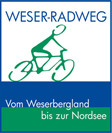The town of Höxter combines picturesque half-timbered houses and medieval alleys with a lively city center. The wide variety of restaurants and beer gardens invites you to take a break. In Höxter, you will find some of the most important buildings of the Weser Renaissance with magnificently decorated facades. A highlight is the Forum Jacob Pins, which offers an attractive mix of historical architecture and the works of the artist Jacob Pins. In the leisure facility Höxter-Godelheim directly on the Weser cycling route, you can cool off. The freely accessible swimming and recreational lake entices with a spacious and well-maintained fine sandy beach.
A little further north, directly on the main route of the Weser cycling route, is the UNESCO World Heritage Site Corvey. The current castle and former monastery is a cultural center of the region as a historic monument, museum, and event venue. It houses, among other things, a regional museum, an exhibition on the history of the town of Höxter, as well as the princely library.
The onward ride along the Weser takes you to Holzminden, also known as the "City of Scents and Flavors." Here, during a fragrant city tour, you can discover the sights of the town with your "nose" at 18 scent steles. The event highlight is the biennial "International Street Theatre Festival Holzminden" (2019), the first and internationally most renowned festival of this genre in Germany. Still in Holzminden, you then have to decide on which side of the Weser you want to continue cycling. On the right side, the main route, is the Weser Renaissance castle Bevern, a magnificent water castle with a picturesque courtyard. From Bevern, it goes on to Polle, where you can change Weser sides with the historic reaction ferry. Here, Cinderella calls Everstein Castle home and regularly performs at the Cinderella open-air play.
You continue through the Rühler Schweiz, where the Cherry Blossom Festival is celebrated in spring amidst a landscape covered in white blossoms. This leads you to Bodenwerder, the home of the legendary Baron von Münchhausen. Traces of the incomparable fabulist can be discovered in the Münchhausen Museum, on a tour through the historic old town, at the Münchhausen play, or during the Münchhausen musical. A visitor magnet is the “Light Festival on the Weser - the Weser Burns,” which takes place every year on the second weekend of August. It features the largest fireworks display in northern Germany.
Via Daspe, where you can see Hehlen Castle on the opposite shore, the main route leads you to the small village of Grohnde. Here, it is worthwhile to cross the Weser side using the historic reaction ferry to make a detour to the magnificent Hämelschenburg. The Weser Renaissance castle is one of the last fully preserved Renaissance complexes in Germany. Guided tours are offered there, and the adjacent buildings, such as the church, the water mill, and the park with the castle café, offer both relaxation and culture. From here, it is only a stone's throw to Emmerthal, from where the path leads via Tündern to the town of Hamelin, famous for its Pied Piper legend. The historic old town scores with numerous restored half-timbered and Weser Renaissance houses.

